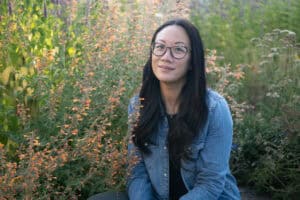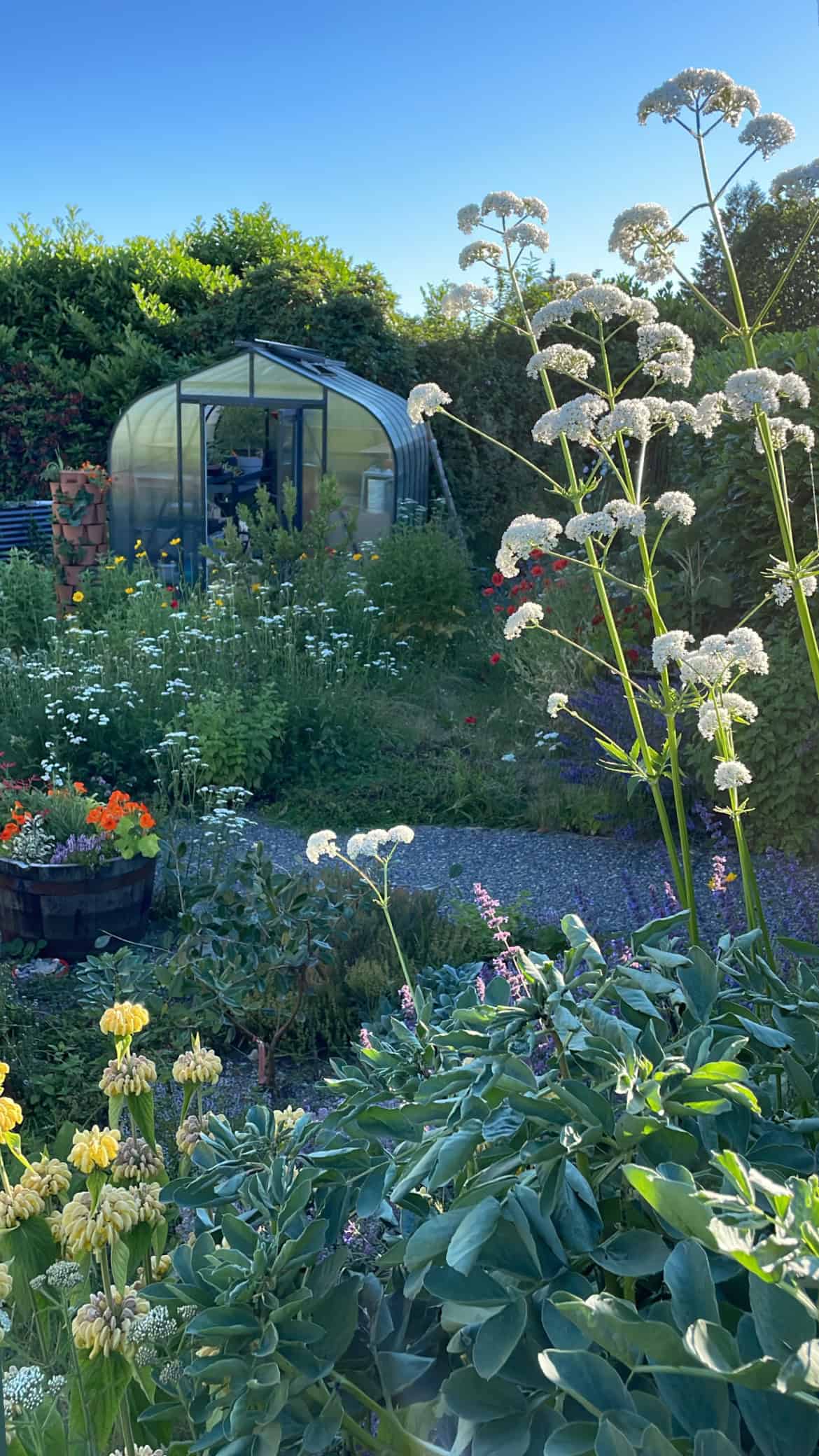A North Shore gardener hopes to inspire a food forest in local neighbourhoods in her new book. Author Chris Chung takes food out of rigid backyard beds and into our residential yards in The Layered Edible Garden.
Rethinking traditional
Sitting on a shelf in Lynn Valley’s Maple Leaf Garden Centre there is a new resource available for gardeners looking to have a more natural and fruitful garden. Local gardening expert and writer Chris Chung has put much of the knowledge she generously shares on local gardening Facebook groups and on YouTube into her book The Layered Edible Garden and you might even find her nearby to answer some questions. While working as an instructor at the UBC Botanical Gardens a chance conversation led to inspiration and a passion to rethink home gardens.
 “Not everyone wants to convert a garden into a food garden because not everyone loves the aesthetic of traditional food gardens where everything is in rows and boxes,” she said. “I started looking at the idea of food forests. Why are we not incorporating some of these practices into traditional landscape horticulture? There are plants that are non-traditional yet practical, beautiful, functional and many of them are actually suited to the climate here.”
“Not everyone wants to convert a garden into a food garden because not everyone loves the aesthetic of traditional food gardens where everything is in rows and boxes,” she said. “I started looking at the idea of food forests. Why are we not incorporating some of these practices into traditional landscape horticulture? There are plants that are non-traditional yet practical, beautiful, functional and many of them are actually suited to the climate here.”
With that seed of inspiration, Chung began to tackle her own front garden
“I thought, well, why don’t I just try this out myself? I mean, selling this idea is great, but until I try it and have a feel for it, is it doable? Does it actually look good? And so for the past few years, I have been practicing, mixing and matching plants in the garden.”
Mind shift
Residential gardening is having a bit of a change of identity, said Chung. As we become more environmentally conscious, more gardeners are interested in working with the ecology and weather we have, rather than creating a “picture perfect” garden from some other place. For some, this change may bring relief, and for others discomfort.
 “At the end of the day, you just want plants to be happy. When a plant that is not healthy and dislikes the conditions, as gardeners, we interpret that as, oh, we’re not good gardeners or it was my fault. But you know, sometimes it could just be a fussy plant.
“At the end of the day, you just want plants to be happy. When a plant that is not healthy and dislikes the conditions, as gardeners, we interpret that as, oh, we’re not good gardeners or it was my fault. But you know, sometimes it could just be a fussy plant.
“But I think mixing and matching is a lot of fun. Food especially doesn’t need to just live in a food bed or a food section of the garden. That’s kind of like the big picture rethinking that I am trying to share with people.”
Chung hopes we can use the garden spaces we have more efficiently. Incorporating foods into the decorative portions. She thinks this is a better use of our time and resources.
“The less we need to fight with our garden, the better. You can enjoy it. You can focus your energy, money and resources like water to growing things that are purposeful and may improve the impact on local creatures. It’s just so exciting because there are so many areas that we can all explore. I find every season I’m learning something new because I never thought about that but the garden grows and it does something wild and it presents neat stuff.”
Planting purposefully
For a diverse productive garden, Chung suggests we think beyond typical apple trees and rows of carrots as well as straying a bit further from the typical manicured garden aesthetic.
“If you’re a homeowner, you may feel the need to match the look of your or might have limitations to the time you have to maintain it. I think just being honest and realistic with yourself like you know what can I work on this. I am encouraging people to mix and match. There are no rules once you understand the conditions of your garden and what is going to thrive and work well.”
There are realities of North Vancouver that can present some challenges. The yards with cedars tend to be shaded and have acidic soil. The amount of sunlight varies greatly. There are many yards in Lynn Valley and Deep Cove where growing tomatoes can be very difficult, said Chung.
 “We have to be realistic and it may not be even apples. They need the sun, Certain berries want more sun. Most of the fruiting things want the sun. But I think that kind of forces us in a good way to explore what could grow here. And it may not be the big trees with lots of fruit that you can harvest in the summer. It could be smaller fruit that are adapted to part shade.”
“We have to be realistic and it may not be even apples. They need the sun, Certain berries want more sun. Most of the fruiting things want the sun. But I think that kind of forces us in a good way to explore what could grow here. And it may not be the big trees with lots of fruit that you can harvest in the summer. It could be smaller fruit that are adapted to part shade.”
Chung looks to cooler-temperature veggies and shrubs.
“In this area, I always like talking about currants and black currants. They’re great and they do fruit well with partial sun. A lot of the Asian leafy veggies like the weather that we’re getting right now where it’s kind of cool and wet and damp. They grow beautifully.”
The resulting garden is a bit wilder and less formal. Her own garden reflects that.
“It breaks some rules when it comes to how planting should look. I’ve got something tall here, something small there. I’m honestly just experimenting. I learned something. Let’s not repeat it. What could be a better option? And if nothing is the better option then maybe I can just put some rock there, or put a planter there, where I can remove the plant and tuck it into the shade if it’s like a super hot, scorchy spot.”
Tips
The best resource to influence your garden is local knowledge, said Chung. Besides options like her new book, there are gardening groups in person and online that offer a wealth of relevant information. Gardeners tend to be proud of their work and sometimes chatting on the street offers the best practical guidance. That can also be an affordable way to try a new plant.
“Some people are just pruning anyway and they’re happy to give cuttings away. So that’s a way you can get around a really expensive plant and buying from nurseries – look for plant swaps. A lot of people are pruning their figs and elderberries. I usually prune my goji plants in late winter and I give cuttings away. They root so easily but if you go to any nursery they are $29 or more for one gallon.”
Another consideration when looking at food gardens for Lynn Valley is wildlife.
“It’s a real thing, wildlife. As much as we want to romanticize growing an orchard, we have bears walking into our carport from the wooded area. We have to think about wildlife, not just bears coming down and eating fruit, it’s also our maintenance practices. What smells good for us, smells good for the raccoons, bears, and whatever else. If anything is not harvested, it’s going to bring more of those black bears into the property, which, as we all know, is a not good thing for the bears.”
The weather up here, in Lynn Valley, can be very different from the flatter, drier land near Park and Tilford.
“If you’re deeper into the valley or further up, you’re going to get cooler, moist pockets, which are maybe great for certain plants, like, cool season veggies, but may not be the best for Medaterrian plants like rosemary or bay laurel.”
As the growing season creeps ever closer Chung encourages residents to bide their time.
“It’s so tempting to put out warm season crops, like tomatoes,” she said. “For the past two years, I haven’t planted before June. Just because the weather is so unpredictable, we could be getting a long, cold, wet spring, which is not good for those heat-loving plants. In a nutshell, the tip is to be patient and wait until we get consistently warm soil. A good investment is to get a soil thermometer and test once a day. And if the temperature is consistently at or above 10 Celsius, that’s a good sign.”
You can find Chung’s book The Layered Edible Garden at Maple Leaf Garden Centre or on Amazon.
Looking for more?
There’s always something fun and exciting happening in Lynn Valley. Check out our Community Events Calendar or learn more about Local Activities, Mountain Biking or Hiking and Walking Trails.

